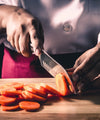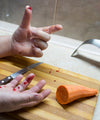Recent Post
Archive
- November 2021
-
- How to choose the right kitchen knife for the right chopping job.
- How to help reduce 60,000 knife accidents a year in the kitchen!
- HELPING THE EARTH – Why Bamboo chopping boards are the best?
- What is the BEST kitchen chopping board type?
- The Best Kitchen Knives & Why?
- Save Money – On GREAT kitchen knives
- October 2021
Tags
Custom Menu

How to help reduce 60,000 knife accidents a year in the kitchen!
The kitchen is the heart of most homes in the UK, but it is proven to also be the most dangerous place in the home for accidents.
National statistics confirm the kitchen is the most likely location for accidents in the home, far more so than the garden or home gym!
Every year, over 100,000 people are injured in a kitchen related accident in the UK.
Do you know what the most common accident in a UK kitchen is?
A staggering 60% of those 100,000 injured are from cuts from the humble kitchen knife.
60,000 knife accidents a year in UK kitchens!
The cause of the 60,000 accidents?
It is continually proven that a dull or blunt blade is far more dangerous than one that is sharp.
And / or the wrong chopping board is used.
The reason?
A dull knife blade requires far more pressure applied to cut, slice or chop food. This extra pressure combined with a blunt knife blade can cause the knife to easily slip from the food you are preparing and in most cases the blade comes into contact with the worker's other hand, causing a laceration to the hand and/or fingers.
The solution?
There are 5 main areas,
1) Sharp knife blades
2) The correct chopping board material
3) Cutting / chopping food correctly
4) Knife blade protectors
5) Respect for knives when cleaning
Follow the guide on the 5 point solution below,
1) How to sharpen kitchen knives?
There are three main ways to sharpen kitchen knives,
a) Using a simple, QUALITY, tungsten and ceramic pull through sharpener
b) Using a traditional Honing rod
c) Using a Whetstone
It’s fair to say that knife sharpening is not something that appeal to many people, hence 60,000 accidents a year due to dull knife blades!
Also, the reality is, in today’s modern world, that speed and ease of knife sharpening appeals more to us than the more laborious traditional knife sharpening way of Honing Rod or Whetstone!
So, sharpening by way of a simple, QUALITY, diamond and ceramic pull through sharpener appeals far mor to us…
Here we look at all 3 ways of sharpening and highlight the pros and con’s
Tungsten Steel & Ceramic Rod - Pull through sharpener
Maybe not the choice of professional chefs (as they tend to like traditional methods) but certainly the favoured choice of ‘home chefs’ in ‘home kitchens’
How to use?
Stage 1 - Really very simple, simply insert the blade into the TUNGSTEN STEEL slot initially (SHARPENS THE BLADE), then pull the blade though (one direction only NOT back and forth) several times.
Stage 2 – Then, simply insert the blade into the CERAMIC RODE slot (HONES THE BLADE), then again, pull the blade though (one direction only NOT back and forth) several times.
Pros
Easy to use
Hones AND sharpens blades
Inexpensive
Fits into small drawer
Cons
Life span – manufactures suggest 5,000 sharpening pull throughs
Typical cost range
£10.95 - £38.95
Honing Rod – Sharpener
A honing rod, also sometimes called a "sharpening steel", a bit of a misnomer since the steel "corrects" or "trues" the edge but does not really sharpen it, can help return the blade to its a honed condition by smoothing the blade edge of burrs.
In reality, a lot of ‘home chefs’ in ‘home kitchens’ don’t really like this method, they see it as complicated.
How to use?
Honing rods have one grit type.
In essence sharpening is a process of sliding the knife up and down the honing rod.
Pros
Relatively easy to use (will take practice)
Life span
Cons
Time consuming to use
Only ‘hones’ knife blades
Difficult to store
Typical cost range
£20.00 – to a massive £225.00
Whetstone - Sharpener
The TRADITIONAL knife sharpening method, but by far the least favourite method as they see it as far too complicated, messy and dirty to use.
However, die hard puritans of knife sharpening PREFER this method over any other.
How to use?
Some manufactures recommend soaking these in either oil or water before sharpening however others say that creates a paste that clogs the open pores of the stone (rendering them less effective).
Whetstones have two sides with two separate grits, fine and course.
In essence sharpening is a process of several stages using both sides of the whetstone and grits.
Pros
Better knife sharpening
Life span
Cons
Time consuming to use
Difficult to use
Dirt and messy
Difficult to store
Typical cost range
£15.00 – £40.00
2) The CORRECT chopping board material
Remember, 60,000 knife accidents a year in the UK due to dull or blunt knife blades!
So, WHAT is the biggest culprit of dulling or blunting knife blades?
ANSWER – The chopping board MATERIAL type!
It’s definitely not the food you’re cutting that continually dulls your knife blades - it’s the cutting surface material type.
Glass, granite and marble are terrible surfaces to cut and chop on and will dull your knives very quickly.
Plastic, it may shock you how bad plastic cutting boards are for your knives and for kitchen safety. Plastic cutting boards are terrible all around: they rapidly dull the blades of your knives, you end up with nasty microplastic particles in your food, and importantly, they are also horrendous for the environment.
Without doubt the best surface to cut food on is a wood chopping board that’s not too hard nor too soft. Bamboo chopping boards, Cherry and Maple are recognised as the best chopping boards.
Bamboo won’t absorb water, crack or peel, has unique anti-bacterial properties and wont dull or blunt sharp knives
The worst woods to use? Avoid softwoods, Acacia, and Oak in any form.
BAMBOO - The best and safest, eco-friendly wood chopping board!
A link to the best chopping boards can be found here.
3) CUTTING / CHOPPING food correctly
1) Choose a wood chopping board
2) Secure the chopping board so it doesn’t slide
3) Use the right knife for the job
4) Always use a sharp knife
5) Always hold your chef's knife with your more dominant hand
6) Form a claw with your subordinate hand
7) Protect the thumb on your subordinate hand.
I. Learn different chopping techniques
II. Learn the cross chop
III. Learn the tap chop
IV. Learn the rock chop
(link back - no follow link here – to trusted source)
4) Knife blade protectors
Using simple knife blade protectors is a must when storing sharp knives in the cutlery drawer.
Why would you want to put your hand into a drawer with razor sharp knife blades facing towards you?
They are also inexpensive.
5) Respect for knives when cleaning
Something often overlooked, knives can be a real hazard when washing up the dishes.
With the sink full with warm soapy water, plates and cutlery a danger looms.
We need to be careful when putting hands into the frothy topped water that has no visibility, as a razor edge knife is waiting to cause damage to the hands!
I hope the links and information in this post help to keep you and the ones you love safe.
← Older Post Newer Post →





